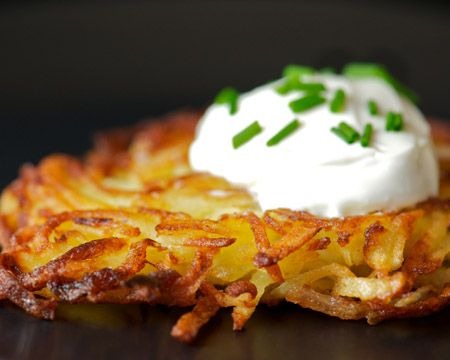Making The Perfect Latkes
The art of making the perfect latke is not one that's easily mastered. In fact, some say it's nearly impossible.
What is a latke, exactly? Latkes are flat, fried pancakes that are typically made with grated potatoes, eggs, onions, matzo meal, and various seasonings. Usually eaten during Hannukkah, they are a Jewish and Eastern European specialty. One area of contention and confusion surrounding latkes is pronunciation. To be clear, it is pronounced as LAHT-KUH. An easy way to remember it? It rhymes with vodka, hence the popularity of Vodka & Latke parties this time of year.
As for making the actual pancakes, there are argued methods and practices that remain family traditions or a matter of personal preference. Chefs and home cooks alike seem to constantly battle over the onions — grated or chopped? — and the type of cooking fat used.
Here, two chefs, Noah Bernamoff from Mile End and Robb Garceau from Great Performances, share their tips and secrets for making the perfect latke (in their opinion, of course). Even in this small selection pool, differing methodologies and strong beliefs are evident and partially convey the vast range of opinons out there in the latke-making world.
Since both chefs are participating in the 2011 Latke Festival, they aren't able to divulge their recipes, so hopefully their tips and opinions will help you make the best possible latke you can.
Noah Bernamoff: Keep it simple. Master the standard potato latke before trying to be a hero with different vegetables and starch contents. Also, don't let recipes fool you into using flour. A real latke always has matzo meal (it will make it much crispier).
Robb Garceau: Keep it simple, use classic russets because they provide the best texture — a creamy interior with a crunch on the outside. Also, make a latke "kit" and have all the ingredients ready to go prior to serving. And, if you must cook the latkes in advance, par-fry them in 300-degree oil (a neutral flavor) for 2 ½ minutes.
Cooking Fat
NB: I like using a mix of vegetable oil and schmaltz (chicken fat). The latter brings the flavor, and the former provides the right frying range. There's basically no upper limit on quantity — just make sure the oil is hot enough so that they don't end up greasy.
RG: I use clarified butter. For extra flavor, mix in shallots, fresh thyme, garlic, peppercorns, or a bay leaf and strain before frying. Duck fat also imparts great flavor.
NB: Not really optional — grating is a must. You don't want to chomp into an onion, you want its subtle sweetness to color the flavor of the fried potato.
RG: Chopped, so that the water stays inside the onion.
Click here to see How to Chop an Onion and Not Cry.
OK to Use a Food Processor?
NB: My nana would kill me for saying this, but a food processor works fine. The key is to use a large grating disc. It's definitely not suitable, however, to use the chopping blade and simply pulverize the potato.
RG: NEVER. It makes for a gummy, watery latke — plus I like the exercise!
Best Way to Squeeze Liquid From Potatoes?
NB: I recommend rinsing the grated potato in cold water, laying it out over a raised rack with a sheet of cheese cloth, salting it, and letting it rest for an hour. Then, squeezing it out in a clean dish towel held vertically to let the moisture run off.
RG: Yes, in a clean kitchen towel, ringing them out like you're trying to dry out the towel. This way the latke stays together better, packing in the potato for even crisping.
Unusual Seasonings and Fun Twists
NB: I'll sometimes toss in finely chopped chives to bring out some of the onion-y qualities of the latke, but otherwise it's usually straight ahead salt and fresh cracked pepper. I've pinched some nut flour into the mix with good results, too.
RG: Inside the latke itself, I like to add a little ground Aleppo pepper or smoked paprika for a little kick. Herbs aren't a great idea because they burn. Lemon zest is great for a little freshness and brightness.
NB: My favorite is unsweetened, tart applesauce made from late autumn cooking apples like the inexpensive Cortland variety. A spiced sour cream also does a nice job of cutting through the oiliness of the latke.
RG: For a classic topping, try mixing a dollop of jarred horseradish into some crème fraîche with a dash of lemon juice and chopped fresh dill. Top with smoked salmon, smoked trout, or roasted, shredded beets.
Drink Pairings
NB: The marriage of latkes and apples always inspires a nice cider — the cool alcoholic variety as well as the warm, mulled variety.
RG: Beer or hard alcohol — the latter helps with digestion.



